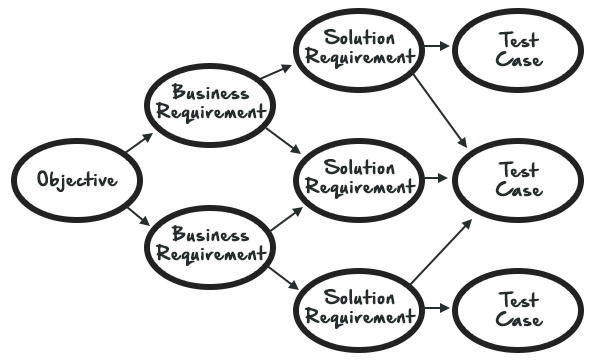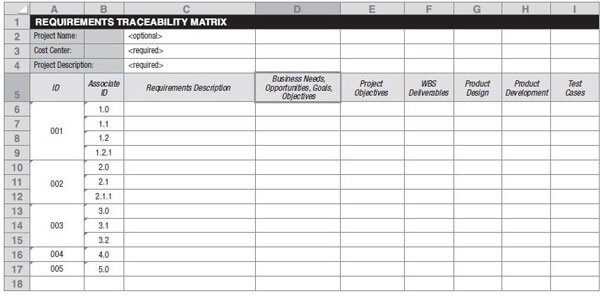
“All things are poisons, for there is nothing without poisonous qualities. It is only the dose which makes a thing poison.” (Paracelsus)
Requirements traceability is a concept related to requirements management which often provokes negative thoughts of complex tools, a lot of work, and an unnecessary loss of time. However, as with most business analysis techniques and disciplines, finding “just the right amount” can provide a significant benefit to the project.
In this post, I will explain the benefits of traceable requirements to projects and how to do it efficiently.
Traceability involves establishing an imaginary line from the requirements to related items such as test cases or releases. It allows for documentation of dependencies between requirements and with other important elements in the project (technical design, code components, test cases, releases, incidents, etc.). The illustration below demonstrates this concept:

In business analysis, we carry out traceability to ensure that the requirements are approved and managed correctly throughout the project lifecycle.
Many complex tools are available that provide full management of requirements, such as Enterprise Architect, CaliberRm, and Blueprint. However, if you don’t have access to one of these tools, or desire a simple solution, a traceability matrix (like the one below from PMI®) will do the job. It’s important to focus on completing the actual task and not on the technology.

Good traceability of requirements offers us the following benefits:
Since traceability allows each requirement to be associated with the appropriate business objectives, we can evaluate the value of each requirement. This allows us to effectively prioritize and avoid scope creep (the frustrating sensation of there being never-ending requirements for this project).
Good traceability allows us to evaluate the impact of a potential change quickly and easily. For a given requirement, we can identify the related business objectives and other affected components. In addition, traceability allows easy identification of requirements associated with a failed test case, which supports accelerated resolution of problems.
Traceability allows for identification of critical dependencies between requirements, supporting better visibility and control of these relationships.
Identifying relationships between requirements and related items helps us to be more consistent and coherent. We can detect and correct inconsistencies quickly and use the same terminology. For example, if we use two different terms to refer to the same entity, such as Client and Registered Customer, connecting related requirements may help us see the inconsistency more easily.
The traceability matrix can be used to help manage which requirements are validated, which are pending, and which have been rejected. It also helps in identifying which requirements correspond to a specific release.
No matter what the project, I believe the minimum set of elements that must be traced consists of business objectives, solution requirements, test cases, and releases. However, a single traceability solution for all projects is not a good idea. When deciding on the level of traceability and the necessary work and tools, we must consider the following aspects:
Remember: no matter what the tool, if it does not represent reality, it is useless. The benefits of a traceability system are only realized when it is used consistently and continuously.
Saludos cordiales,
Alfred

© Copyright 2023. Netmind. All rights reserved.
Por favor, proporciona la siguiente información para ayudarnos a personalizar la solución.
Netmind España
Barcelona +34 933 041 720
Madrid +34 914 427 703
Nos puedes encontrar de:
Lunes – Viernes, 9:00-18:00 (GMT+1)
¡Te ayudamos!
info@netmind.net
¿Dudas sobre servicios/formaciones?
comercial@netmind.es